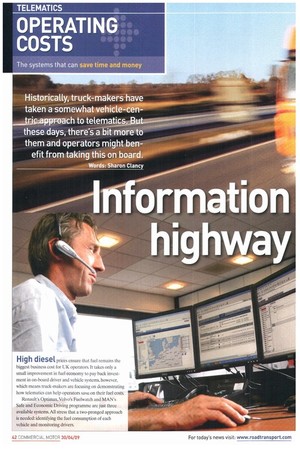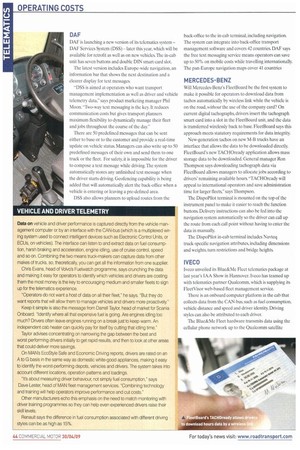OPERATING COSTS
Page 42

Page 44

Page 45

If you've noticed an error in this article please click here to report it so we can fix it.
The systems that can save time and money
Historicatly, truck-makers have taken a somewhat vehicte-centr` pp mach to te1ematics,J3ut, these days, there's a bit more to them and operators might ben efit from taking this on board.
Words: Sharon Clancy
High diesel. prices ensure that fuel remains the biggest business cost for UK operators. It takes only a small improvement in fuel economy to pay back investment in on-hoard driver and vehicle systems, however, which means truck-makers are focusing on demonstrating how telematics can help operators save on their fuel costs.
Renault's Optimax, Volvo's Fuelwatch and MAN's Safe and Economic Driving programme are just three available systems. All stress that a two-pronged approach is needed: identifying the fuel consumption of each vehicle and monitoring drivers.
DAF
DAF is launching a new version of its telematics system — DAF Services System (DSS) — later this year, which will be available for retrofit as well as on new vehicles, The in-cab unit has seven buttons and double DIN smart-card slot.
The latest version includes Europe-wide navigation, an information bar that shows the next destination and a clearer display for text messages "DSS is aimed at operators who want transport management implementation as well as driver and vehicle telemetry data," says product marketing manager Phil Moon. -Two-way text messaging is the key. It reduces communication costs but gives transport planners maximum flexibility to dynamically manage their fleet and jobs throughout the course of the day."
There are 50 predefined messages that can be sent either to base or to the customer and provide a real-time update on vehicle status. Managers can also write up to 50 predefined messages of their own and send them to one truck or the fleet. For safety it is impossible for the driver to compose a text message while driving. The system automatically stores any unfinished text message when the driver starts driving. Geofencing capability is being added that will automatically alert the back-office when a vehicle is entering or leaving a pre-defined area.
DSS also allows planners to upload routes from the back-office to the in-cab terminal, including navigation. The system can integrate into back-office transport management software and covers 42 countries DAF says the free text messaging service means operators can save up to 50% on mobile costs while travelling internationally. The pan-Europe navigation maps cover 41 countries
MERCEDES-BENZ
Will Mercedes-Benz's FleetBoard be the first system to make it possible for operators to download data from tachos automatically by wireless link while the vehicle is on the road, without the use of the company card? On current digital tachographs, drivers insert the tachograph smart card into a slot in the FleetBoard unit, and the data is transferred wirelessly back to base. FleetBoard says this approach meets statutory requirements for data integrity.
New-generation tachos on new M-B trucks have an interface that allows the data to be downloaded directly. FleetBoard's new TACHOready application allows mass storage data to be downloaded. General manager Ron Thompson says downloading tachograph data via FleetBoard allows managers to allocate jobs according to drivers' remaining available hours. "TACHOready will appeal to international operators and save administration time for larger fleets," says Thompson.
The DispoPilot terminal is mounted on the top of the instrument panel to make it easier to reach the function buttons. Delivery instructions can also be fed into the navigation system automatically so the driver can call up the route from each call point without having to enter the data in manually.
The DispoPilot in-cab terminal includes Navteq truck-specific navigation attributes, including dimensions and weights, turn restrictions and bridge heights.
IVECO
Iveco unveiled its Blue&Me Fleet telematics package at last year's IAA Show in Hannover. Iveco has teamed up with telematics partner Qualc,ornm, which is supplying its HeetVisor web-based fleet management service.
There is an onboard computer platform in the cab that collects data from the CAN-bus, such as fuel consumption, vehicle distance and speed and driver identity. Driving styles can also be attributed to each driver.
The Blue&Me Fleet hardware transmits data using the cellular phone network up to the Qualcomm satellite platform. From there, the vehicle operator can access fleet information via the FleetVisor platform. Data can be integrated into existing in-house software systems.
A Bluetooth connection between the onboard blackbox and internal displays allows operators to choose the type of portable computer that best fits their set-up.
There is also an interface with the digital tacho to allow remote card authentication and download of the data.
MAN
MAN's Teiematics Services division has introduced its EcoStyle driver performance monitoring application that includes lots of detail, but presents it in a style that makes it easy for managers to analyse aspects of the business.
It categorises depots, fleets and individual drivers on a seven-point scale that mimics the energy ratings given to domestic appliances. So A (for absolute star) is the greenest, most efficient driver, while a driver rated 0 is so had it's 'goodbye', says head of fleet management services Dave Lester. He adds that an analysis of more than 1,000 drivers revealed 80% fell into the C (competent but could improve) and D (driver development required) categories.
The colour-coded buttons are applied through the various reports, providing an at-a-glance comparison of depots, vehicles and individual drivers. As well as seven driver ratings, there are seven key monitoring items. including over-speeding, en0e idling, sweet spot driving, and correct use of gears. Managers can drill down to individual levels to check if a driver who is above average in general is, for example, below average on one aspect.
RENAULT
Renault says operators that analyse fuel consumption can save up to 10% on fuel costs. While it doesn't offer a conventional telematics package with wireless over-theair data downloads, the group has developed a driver and vehicle analysis program for its Infomax diagnostic software. Data is downloaded from the vehicle Onboard Diagnostics Port (OBD) to a laptop, where driver and vehicle telemetry information can be analysed instantly. The software uses the red-amber-green traffic light system to alert managers to poorly performing trucks and drivers.
All new Renault trucks above 7,500kg are equipped with an Infomax plug, and there are also plugs for Euro-2 and Euro-3 trucks as well as current production modules.
SCANIA
Scania On Board combines vehicle and fleet management software. EMS aims to deliver flexible services operators can 'pick-and-mix' to suit their operational needs. "Experience has shown that to get the optimum solution for their needs, operators want to pick different elements from the various platforms. The menu-style subscription service will help them get exactly what they need," says head of marketing for Scania Onboard Darrell Taylor.
There is a choice of hardware platform and all hardware is built to Open Database Compliance standards for easy integration into existing transport management software. The Order Support application bridges the gap between an existing transport management system with routing and scheduling and the vehicle itself. Scania says the system is flexible and can be tailored to suit customers' needs and third-party.
VOLVO
Volvo's Dynafleet telematics system plays a key role in the lirrn's Fuelwatch fuel-cost reduction campaign. "Even a fuel consumption reduction of two or three litres per 100km can have a positive effect on the bottom line for the majority of hauliers," points our. Chris Evans. Dynafleet monitors fuel-tank levels and provides fuel usage reports, which can be assigned to drivers as well as vehicles via the driver cards that are inserted into the in-cab terminal at the start of each day.
There are three packages: Perform is the basic vehicle and driver performance monitoring system that collects data on fuel consumption, driver behaviour and allows managers to check service intervals; Perform and Locate adds vehicle tracking and street-level mapping; and Operate boasts text communications.
Maintaining driver skills is essential if you want to improve fuel economy, and Volvo has devised a webbased driver training programme. For operators that also want to identify the effect their operations have on the environment, Dynalleet can also produce CO, emissions reports. •












































































































































